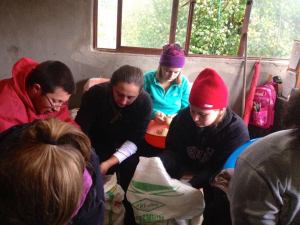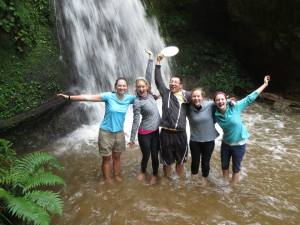Well, we knew this would happen eventually, but I had hoped I would be a little more on top of this blog thing. The downside of having so much excitement on this trip is that I don’t have much time to write about it! Since I haven’t written a post in a while, instead of talking about what I’ve been doing for the past 10 days I think I’ll just focus on our trip to a Pueblo (indigenous community) in the Sierra Norte. I’ll talk about what we did each day, with lots of pictures, and then some of my general observations about the trip and other things of note.
Last Thursday was our last day of Spanish classes (an essay due and an exam… one reason I haven’t updated this for a while!) and right afterward we boarded a bus to go to Neveria, a Pueblo in the Sierra Norte de Oaxaca. Roadtrip!

The drive was absolutely beautiful, and it was very refreshing to leave the city of Oaxaca and travel into the mountains. For example:

When we arrived at la Neveria, we had comida straight away (and we were very hungry, having not eaten between 8:30 am and 4 pm). Every meal began with the same question: ¿Quieres chocolate de agua (Hot chocolate in water) , chocolate de leche (hot chocolate in milk), agua de sabor (fresh fruit juice), o te (tea from a local mint-ish herb called Poleo)?. The choice was pretty obvious for me and many others, with choruses of «chocolate de leche, por favor!» around the table. Because it’s not just hot chocolate, it’s Oaxacan delicious thick milky chocolate (choco-lat-ay). Before eating we were served fresh bread with our drinks, which we learned how to make later on. The whole weekend we were served delicious food, with fresh homemade corn tortillas, vegetables grown in the community, local chickens, different homemade salsas… you get the picture.


After la comida we walked around the community for a while and set up our cabanas (cabins). We all sat and played Egyptian Rat Screw and other card games, and had good bonding experiences. That was one of my favorite parts of the trip– we were pretty isolated and disconnected from the outside world and spent a lot of time together, so I definitely got to know everyone a bit better! Then we had dinner, made a fire in our cabins, and got a good nights rest to prepare for the day ahead.

The next day, we woke up and had a delicious breakfast, then went to work in the invernaderos (big greenhouses where most of the community’s food is grown). We used picks and hoes to till the soil, dug trenches for the irrigation system, and planted flowers, stopping for carrot and radish breaks every so often.


Next, we had la comida (is it obvious that my days revolve around food?) and then worked for another few hours de-kerneling (desgranando) corn by scraping off the kernels of dried corn with another piece of already de-kerneled corn. Corn is a staple here in Oaxaca– it’s the main ingredient in most food from tortillas to tamales to soup, so the corn that we de-kerneled (I’ve used that word three times now, I think that makes it official) will be put to good use in Neveria!


We then returned to our cabanas, hung out together for a bit and had dinner, and then we had a member of the Pueblo come to our cabana, with a fire lit, and tell us the history of Neveria. Neveria, and the neighboring Pueblos, are part of a coalition of indigenous communities called «Pueblos Mancomunados Oaxaca» which specializes in Ecotourism. The communities have had trouble maintaining their population and culture, creating livelihood for their people, and just surviving in a world that doesn’t value the importance of indigenous groups nearly as much as it should. In the face of these challenges, these Pueblos (which are Zapotec in origin) decided to create a network between each other where foreigners, Mexicans, people of other indigenous groups, etc. could pay to stay into their communities, observe and be involved in their fascinating cultural practices and heritage, and enjoy the beautiful scenery and outdoor activities that these mountains have to offer, all in an environmentally conscious way. Side note: this is not the environmentalism of choice of the Pacific Northwest. It’s environmentalism of necessity– to preserve the surrounding forests and their other natural resources, not pollute or overwork their land or water supply, and provide their people with healthy and nutritious food, they have to live in a way that minimizes their footprint on the land. And, really, shouldn’t everyone view environmentalism this way?
The next day we got up early, had desayuno, and hiked to a neighboring Pueblo, Latuvia, which is about 4 hours away and also part of mancomunados. The hike was gorgeous– it felt like I was back in Washington or Montana hiking through forests, meadows, and always having a great view of the valley below and surrounding mountains. When we got to Latuvia we had lunch and then went to a small building where a woman makes hundreds of loaves of bread every day. And this bread is delicious. It’s in small oval-shaped loaves, and the dough has bits of cloves, anis, and sugar. We kneaded the dough together and shaped it into loaves, and then put them into the forno (a large stone oven where you build a fire before you use it to heat it up, then take out all of the coals and the heat stored in the stones cooks the bread).  (Kneading bread)
(Kneading bread)
While the bread was baking we observed how to make a traditional drink called Tepache, which tasted to me tasted like alcoholic vinegar but is very common in Latuvia.
Our activities in Latuvia finished, we headed back to Neveria. Instead of hiking back, we were transported in the back of a truck. We started the trip sitting, but then realized we could stand up, which was way more fun.


As we rode back it began to get darker, and it was amazing to look up at the stars and down to the lights of the valley below. It sounds like it would be loud and adrenaline-y, but the truck didn’t go very fast and most of the time we stood in silence looking at the scenery around us by the light of the stars. It was a great time to reflect on my experience so far in Oaxaca, a time to take a step back, look at the stars, and realize how lucky I am to be here and having such wonderful and formative experiences.
On our last day (Monday) we took another hike to a nearby waterfall. It was a gorgeous trek through the forest, with a beautiful destination. We crossed the creek and waded into the waterfall area, and got really wet but had lots of fun!

Then we came back, helped make our lunch (vegetable soup, chicken, and rice), loaded our bus, and left Neveria to come back into the city. So, that was our trip!
I’m sure it’s obvious that I relished the opportunity to live in an indigenous community for a short time and experience some aspects of their culture, but the dynamic was also a little weird. It’s tourism of a people– paying to see the exoticness of their culture and be involved in small snippets of their daily lives like working in the greenhouses or making bread– which sometimes felt exploitive, like the people that go to Pennsylvania to gawk at the way that the Amish live. There are definitely key differences: this is a deliberate choice of the people to show the world the richness of their culture while simultaneously obtaining resources to preserve it, the members of the Pueblos are in charge of every step, and all of the benefits go directly to the communities involved, but it’s a concept that could go very wrong if mishandled or taken out of the hands of the communities. But, I really feel like these communities are doing it the «right» way, with every decision guided by respect for the culture and a necessity to preserve it, and I would highly recommend Ecotourism as a neat way to travel.
Other things of note:
1. The day we came back, Monday September 15th, is the day before Mexican Independence Day. People here celebrate it kind of like we celebrate new years, with a big party the night before. So right after we got home from the Mountains, we quickly went to our houses, showered, and met up an hour later to go out to dinner and down to the City Center, where there was a concert, lots of food and vendors, and hundreds of people out celebrating independence.
2. This week we started our schedule for Term II, so I am now taking Anthropology and Literature classes (all in Spanish) on Mondays and Wednesdays. That means that I have a lot of homework due on Mondays and Wednesdays, but I also have a lot more free time! Maybe that means I’ll be better about updating my blog.
3. Yesterday we found out where we will be doing our internships for our last month here. Me and Madeleine will be working with AMEXTRA, a Mexican NGO that is everything I wanted my internship to be! This is their vision statement:
«We are a non-profit organization that promotes sustainable changes through accompaniment and empowerment of community leadership and local participation. Through this work, we aim to transform the quality of life for those in marginalized communities while instilling values of service, compassion and justice.»
And their website is here, if you’re curious: http://www.amextra.org/en/
Well, I should get back to all that homework due on Monday now. Thanks for reading, you’ll be hearing more from me soon! 🙂
-Ellie
(Also, I have not taken very many pictures but am instead using pictures of others in my group– with their permission of course! So the photo credit for these photos goes to Sydney Otey, Giovanna Urdangarain, and Mariann Funkhouser).

